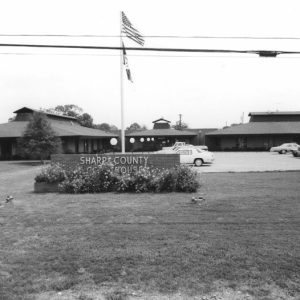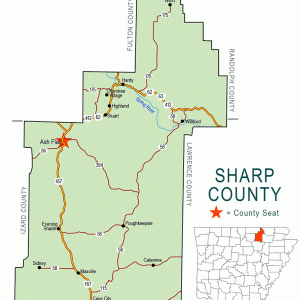calsfoundation@cals.org
Ash Flat (Sharp County)
County Seat
| Latitude and Longitude: | 36°13’26″N 091°36’30″W |
| Elevation: | 670 feet |
| Area: | 6.31 square miles (2020 Census) |
| Population: | 1,137 (2020 Census) |
| Incorporation Date: | May 8, 1931 |
Historical Population as per the U.S. Census:
|
1810 |
1820 |
1830 |
1840 |
1850 |
1860 |
1870 |
1880 |
1890 |
1900 |
|
– |
– |
– |
– |
– |
– |
– |
– |
– |
– |
|
1910 |
1920 |
1930 |
1940 |
1950 |
1960 |
1970 |
1980 |
1990 |
2000 |
|
– |
– |
– |
315 |
265 |
192 |
211 |
524 |
667 |
975 |
|
2010 |
2020 |
|
|
|
|
|
|
|
|
|
980 |
1,137 |
|
|
|
|
|
|
|
The northeastern Arkansas town of Ash Flat is a significant agricultural, medical, and retail district serving the needs of Sharp County since 1856.
Louisiana Purchase through Early Statehood
The area that would become Ash Flat was first settled by farmers in the 1820s, when Arkansas was still a territory. After the state was admitted to the Union in 1836, the Ash Flat area was located within Lawrence County. The community emerged as an important agricultural trading center, and in 1856, the town of Ash Flat was founded when a U.S. post office was built. A group of local residents, led by postmaster James McCord, chose the name Ash Flat because of a nearby grove of ash trees.
Civil War through the Gilded Age
Arkansas’s secession from the union in May 1861 was greeted with enthusiasm by Ash Flat citizens, who supported the Confederacy. The only significant engagement in Sharp County took place in the early 1864, when the Third Missouri Confederate Cavalry defeated a unit of Union cavalry near Martin’s Creek. As the population of northeastern Arkansas increased after the Civil War, Ash Flat was carved from Lawrence County and made a part of the newly formed Sharp County in 1868.
Isolated from Arkansas’s major commercial centers, Ash Flat evolved into an important trading destination for the surrounding farm communities. Ash Flat reportedly had, in 1871, a population of 150 people, as well as a blacksmith shop, three stores, two saloons, and a cotton gin. Thomas V. Stephens and R. J. Wilson put the cotton gin near Big Creek so the oxen that turned the tread wheel could have access to fresh water.
By 1889, Ash Flat’s business interests had expanded to include a saddle-making operation, a grist and flour mill, a drug store, a hotel, and a sawmill. The town also had two churches and one physician, as well as Eastern Star and Masonic lodges. In addition to cotton farming, Ash Flat also experienced an increase in lumber production as the nineteenth century ended. Despite the increase in trade, the population of Ash Flat expanded to a mere 200 people by 1889.
Early Twentieth Century
As the twentieth century began, citizens of Ash Flat recognized the need to provide their young people with better educational opportunities. Local citizens W. E. Brawley, J. R. Garner, L. D. Phillips, and R. E. Sample each donated $500 to the town for the construction of a high school. Ash Flat’s first high school, known locally as “The College,” opened its doors in 1905.
By the late 1930s, Ash Flat remained a small but vital agricultural community with a population of 500. The town’s two most important businesses continued to be the cotton gin and mill, which serviced nearby farmers. Other major businesses in 1938 included a hotel, a gas station, a drug store, and six dry-goods stores. Social life in Ash Flat revolved around its distinctive stone schoolhouse and its three churches. The majority of Ash Flat citizens belonged to Baptist, Church of Christ, or Methodist congregations.
World War II through Modern Era
For more than seventy years, Sharp County had two county seats, one in Hardy and the other in Evening Shade. In 1967, the Arkansas General Assembly abolished the dual county locations, and Ash Flat was designated the seat of government for the combined county. The relocation of the county seat improved overall business conditions. Ash Flat also benefited economically from tourism to the Spring River area, although it does not have any resort communities like nearby Cherokee Village (Sharp County) and Hardy (Sharp County). Despite the benefits derived from tourism and the operations of the courts, Ash Flat’s economy suffered as agriculture declined in the 1960s. According to the 2000 census, household income for Ash Flat residents was a mere $16,797, compared to the Arkansas average of $32,182. Also, the unemployment rate was 7.2 percent in 2002. Despite economic decline, Ash Flat has emerged as an important medical community, with several home health services and nursing homes. In addition, Ash Flat is home to the Sharp County Regional Airport. However, one aspect of Ash Flat’s economy has not changed. The town remains a vital retail center with several stores—including Family Dollar, Sears-Roebuck Company, and Walmart Inc.—that meet the consumer needs of area residents. In this way, twenty-first-century Ash Flat operates much as it did when it was founded in 1856.
Education, Industry, Attractions, and Famous Residents
In addition to its important contributions to Arkansas agriculture, Ash Flat also produced a noted educator and a renowned athlete. Born in 1906 in Ash Flat, David W. Mullins served as president of the University of Arkansas (UA) in Fayetteville (Washington County) from 1960 to 1974. Another Ash Flat native made important contributions to major league baseball. Left-handed pitcher Charles Elwin “Preacher” Roe, born in 1915, won 127 games with the Pittsburgh Pirates, Brooklyn Dodgers, and St. Louis Cardinals between the years 1938 and 1953.
For additional information:
Ash Flat Historical Society. Ash Flat History. Mt. Vernon, IN: Windmill Publications, Inc., 1998.
Moore, Caruth Shaver. Early History of Evening Shade and Sharp County. Evening Shade, AR: 1979. Evening Shade, AR: 1979.
Sharp County, Arkansas. http://sharpcounty.arkansas.gov/ (accessed July 19, 2023).
Wallace, Michelle. “Ash Flat Experiences Growth While Retaining Small Town Atmosphere.” Arkansas Democrat-Gazette, October 20, 2006, p. 10S.
G. Wayne Dowdy
Memphis Public Library and Information Center
 Ash Flat Street Scene
Ash Flat Street Scene  "Preacher" Roe
"Preacher" Roe  Sharp County Courthouse
Sharp County Courthouse  Sharp County Map
Sharp County Map 




Comments
No comments on this entry yet.